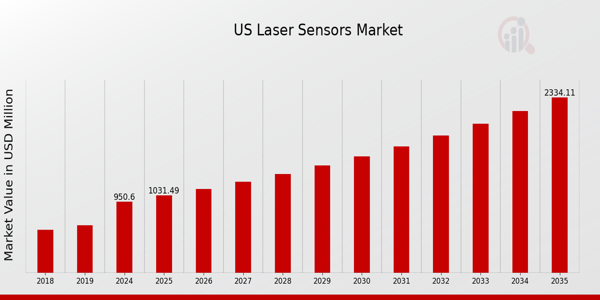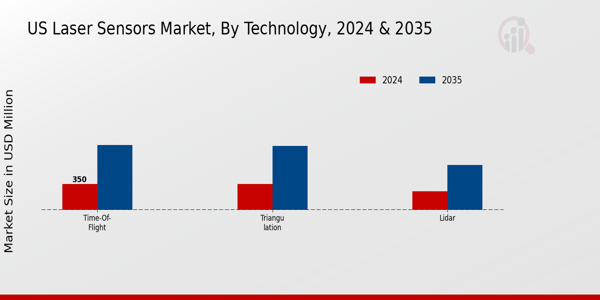US Laser Sensors Market Overview:
US Laser Sensors Market Size was estimated at 889.35 (USD Million) in 2023. The US Laser Sensors Market Industry is expected to grow from 950.6 (USD Million) in 2024 to 2,334 (USD Million) by 2035. The US Laser Sensors Market CAGR (growth rate) is expected to be around 8.509% during the forecast period (2025 - 2035).
Key US Laser Sensors Market Trends Highlighted
The US Laser Sensors Market is influenced by several key market drivers that highlight its growth prospects. The increasing demand for automation across various industries, including manufacturing and healthcare, is propelling the adoption of laser sensors for precision tasks. Additionally, the push for enhanced safety standards in automotive and aerospace sectors has led to a rise in the use of laser sensors for collision avoidance and environmental monitoring. The integration of laser sensors with advanced technologies such as Internet of Things (IoT) is transforming how data is collected and analyzed, further driving their adoption across sectors.
There are numerous opportunities to be explored within this market. Industries such as agriculture are beginning to adopt laser sensors for applications such as crop monitoring and soil analysis, which can enhance productivity and sustainability. Research and development in miniaturized laser sensor technologies also present new avenues for growth, enabling applications in tight spaces and complex environments. Furthermore, as industries shift toward smart manufacturing, the demand for advanced laser measurement tools is likely to increase significantly.
Recent trends indicate a burgeoning interest in the use of laser sensors for non-contact measurements, particularly in the US automotive and aerospace sectors where precision is crucial. The U.S. government has been promoting innovations in sensor technology through various initiatives aimed at enhancing industrial competitiveness. The trend towards environmentally friendly practices is also leading to interest in laser sensors for monitoring emissions and pollution levels, aligning with regulatory requirements. Overall, the US Laser Sensors Market is positioned for significant development as these drivers and opportunities converge.


Source: Primary Research, Secondary Research, MRFR Database and Analyst Review
US Laser Sensors Market Drivers
Growing Adoption of Automation in Various Industries
The increasing trend of automation across various industries in the United States is a significant driver for the US Laser Sensors Market Industry. As organizations seek to enhance operational efficiency and reduce human error, the demand for laser sensors is growing exponentially. According to the U.S. Bureau of Labor Statistics, the manufacturing sector alone projects a need for 4.6 million additional workers by 2030, primarily due to automation initiatives. Established companies like Rockwell Automation and Siemens have been at the forefront of integrating laser sensor technology into their automation solutions, thereby driving market demand.
Additionally, the shift towards automated quality control processes is expected to further stimulate the requirement for laser sensors, which provide precise measurements and data critical for maintaining product quality.
Advancements in Laser Technology
Technological advancements in laser sensor technology are aiding the growth of the US Laser Sensors Market Industry. Recent innovations such as improved laser-based distance measuring tools and enhanced detection capabilities have made these sensors more versatile and effective. The National Institute of Standards and Technology (NIST) has reported that the application of advanced laser technologies has improved measurement accuracy by approximately 30%, according to their recent technical publications. Companies like Keyence and Omron are consistently innovating in this space, developing laser sensors that cater to diverse applications, thus boosting market growth in the United States.
Increasing Demand from the Healthcare Sector
The healthcare sector in the United States is increasingly adopting laser sensor technologies for various applications, including surgical procedures and diagnostic imaging. With a growing aging population and an increase in chronic diseases, the need for sophisticated medical devices that utilize laser sensors is on the rise. The U.S. Census Bureau projects that by 2030, one in five Americans will be of retirement age, increasing the demand for healthcare services. Organizations such as the FDA are supporting the development of advanced medical technologies, including laser-based devices, to improve patient outcomes.
This increasing demand within the healthcare sector is driving growth in the US Laser Sensors Market Industry.
US Laser Sensors Market Segment Insights:
Laser Sensors Market Technology Insights
The Technology segment of the US Laser Sensors Market encompasses a diverse array of methods employed in various applications, driving innovation and adoption across multiple industries. Time-of-Flight technology, renowned for its precision in measuring distances by calculating the time light takes to travel, sees significant utilization in automotive and robotics for applications such as collision avoidance and autonomous navigation. This method is particularly crucial as it supports the growing trends towards automation and smart technologies in the United States.
Triangulation, another pivotal technology, offers enhanced accuracy in close-range measurements and is frequently employed in industrial automation and quality control processes, reflecting the increasing need for precision in manufacturing. Lidar technology, which uses laser light to generate high-resolution maps of environments, is gaining traction in sectors ranging from urban planning to agriculture and environmental monitoring, illustrating its versatility and vital role in developing smart cities and global sustainability efforts. Each of these technologies within the Laser Sensors Market contributes significantly to the overall advancements, embracing the wider scope of applications and aligning with the ongoing shift towards digitization in industries.
This alignment indicates substantial growth potential, driven by the continued integration of advanced sensing capabilities across various platforms, ultimately shaping the future landscape of technology in the United States. The essential focus on safety, accuracy, and efficiency in operations underscores the significance of these technologies, making them central to developments in both existing and emerging sectors.


Source: Primary Research, Secondary Research, MRFR Database and Analyst Review
Laser Sensors Market Type Insights
The US Laser Sensors Market features a diverse range of Type segments, including Laser Displacement Sensors, Laser Distance Sensors, and Laser Speed Sensors, each serving a unique purpose across various industries. The demand for Laser Displacement Sensors has grown significantly due to their precision in measuring distances and heights, making them essential in manufacturing and automation processes. On the other hand, Laser Distance Sensors excel in applications requiring accurate distance measurement over long ranges, thus finding utility in surveying and construction.
Furthermore, Laser Speed Sensors play a critical role in monitoring and controlling motion in various sectors, including transportation and logistics. Given the increasing focus on automation and Industry 4.0 initiatives in the US, these segments are projected to witness substantial growth, driven by technological advancements and a rising need for high-precision measurement solutions. The expanding application areas, coupled with the demand for real-time data and analytics, further enhance the significance of these segments in the US Laser Sensors Market landscape.
As industries continue to prioritize efficiency and accuracy, the relevance of these laser sensor types will persist, fostering innovation and development in measurement technology.
Laser Sensors Market Application Insights
The Application segment of the US Laser Sensors Market encompasses critical areas such as Industrial Automation, Process Control, and Robotics, each playing a vital role in the technological advancement and efficiency of various sectors. Industrial Automation has emerged as a key area driving the demand for laser sensors, significantly enhancing operational accuracy and productivity in manufacturing processes. The Process Control segment benefits from precise measurement capabilities that laser sensors provide, essential for ensuring quality and consistency across different industries, including food and beverage, pharmaceuticals, and chemicals.
Meanwhile, Robotics incorporates laser sensors for various applications such as navigation and obstacle detection, driving innovation and functionality in robotic systems. These applications not only streamline operations but also open opportunities for advancements in smart manufacturing and IoT integration, catering to a rapidly evolving industrial landscape in the US. As industries continue to seek higher efficiency and automation, the significance of laser sensors in these applications remains both prominent and growing, reflecting broader trends towards digital transformation and enhanced operational capabilities across the board.
Laser Sensors Market End Use Insights
The US Laser Sensors Market has been significantly shaped by its diverse End Use applications, which play a crucial role in driving market growth and innovation. The manufacturing sector employs laser sensors for precision measurement and quality control, ensuring consistency and efficiency in production lines. In the automotive industry, these sensors enhance safety and automation, providing critical data for vehicle navigation and collision avoidance systems, reflecting growing trends toward smart vehicles and autonomous driving solutions. Meanwhile, the aerospace sector utilizes laser sensors for various applications including aircraft maintenance and navigation, underscoring their importance in enhancing safety and operational efficiency.
This multi-faceted utilization of laser sensors across these industries signifies their indispensable role, highlighting the need for continual advancements in technology to meet evolving demands. Additionally, the increasing emphasis on automation and smart technology integration in these sectors presents abundant opportunities for future growth within the US Laser Sensors Market. Overall, the interplay of these End Use segments illustrates the vast potential and significance of laser sensors in shaping the future of industrial and automotive landscapes in the US.
US Laser Sensors Market Key Players and Competitive Insights:
The US Laser Sensors Market is characterized by significant competition among various players who are constantly innovating and enhancing their product offerings. This sector is marked by rapid technological advancements, which has resulted in an array of laser sensor products tailored to meet diverse industrial needs. The competitive landscape features established companies that not only focus on improving their existing solutions but also on developing new technologies that meet the evolving demands of various industries such as automotive, aerospace, manufacturing, and automation.
As companies vie for market share, they invest heavily in research and development, strategic partnerships, and marketing efforts to bolster their presence within the market. The US market, being one of the largest, presents immense opportunities coupled with challenges, as players must navigate regulatory environments while addressing customer expectations for quality and performance. Pepperl+Fuchs stands out in the US Laser Sensors Market due to its long-standing reputation for reliability and innovation. The company has developed a strong portfolio of laser sensor products that are widely recognized for their precision and effectiveness in various industrial applications.
Its strategic focus on providing customized solutions has allowed Pepperl+Fuchs to cater specifically to the needs of its clients across different sectors. The company maintains a robust market presence through an extensive distribution network and partnerships with local distributors, thereby ensuring that its products reach a broad customer base throughout the US. Additionally, Pepperl+Fuchs invests significantly in advanced manufacturing technologies, further strengthening its competitive edge by enhancing product performance and delivery times. MicroEpsilon also plays a vital role in the US Laser Sensors Market, known for its innovative and high-quality measurement solutions.
Specializing in laser-based measurement technology, MicroEpsilon offers a range of products, including laser displacement sensors and infrared laser measurement devices, which are critical for applications requiring high precision. The company has built a strong market presence in the US through its ability to provide tailored solutions that address unique measurement challenges faced by industries like automation and quality assurance. In terms of strengths, MicroEpsilon's commitment to research and development is evident in its continuous product advancements and introduction of cutting-edge technologies.
Additionally, the company has engaged in strategic collaborations and partnerships that enhance its market position, allowing for expanded distribution and access to new customer segments. These elements underscore MicroEpsilon's significance within the competitive landscape of the US Laser Sensors Market.
Key Companies in the US Laser Sensors Market Include:
US Laser Sensors Industry Developments
The US Laser Sensors Market has seen significant developments recently. Notably, in August 2023, MicroEpsilon launched a new laser triangulation sensor suitable for high-temperature environments, catering to industries demanding precision amid harsh conditions. Similarly, KEYENCE unveiled advanced laser displacement sensors aimed at improving automotive manufacturing processes, demonstrating the ongoing innovation in this sector. Furthermore, in September 2023, Honeywell announced the expansion of its sensor technology line, including new laser sensors for smart building applications, highlighting their emphasis on the Internet of Things integration.
In terms of mergers and acquisitions, Rockwell Automation entered into a strategic partnership with Omron in July 2023, focusing on automation solutions and smart manufacturing, enhancing their competitive stance in smart factory technology. Additionally, TRUMPF acquired a US-based robotics company in June 2023 to bolster its laser technology offerings. The market valuation for laser sensors continues to grow, attributed to rising demand across various sectors such as automotive, aerospace, and manufacturing, which is driving investments and technological advancement.
Over the past few years, market growth has been marked by an increase in Research and Development spending, ensuring competitive innovation among key players like SICK AG, Cognex, and Panasonic.
US Laser Sensors Market Segmentation Insights
Laser Sensors Market Technology Outlook
Laser Sensors Market Type Outlook
- Laser Displacement Sensors
Laser Sensors Market Application Outlook
Laser Sensors Market End Use Outlook
| Report Attribute/Metric Source: |
Details |
| MARKET SIZE 2018 |
889.35 (USD Million) |
| MARKET SIZE 2024 |
950.6 (USD Million) |
| MARKET SIZE 2035 |
2334.0 (USD Million) |
| COMPOUND ANNUAL GROWTH RATE (CAGR) |
8.509% (2025 - 2035) |
| REPORT COVERAGE |
Revenue Forecast, Competitive Landscape, Growth Factors, and Trends |
| BASE YEAR |
2024 |
| MARKET FORECAST PERIOD |
2025 - 2035 |
| HISTORICAL DATA |
2019 - 2024 |
| MARKET FORECAST UNITS |
USD Million |
| KEY COMPANIES PROFILED |
Pepperl+Fuchs, MicroEpsilon, KEYENCE, Ferrocall, Rockwell Automation, Omron, SICK AG, Cognex, Leuze, Panasonic, KROHNE, TRUMPF, LMI Technologies, Baumer, Honeywell |
| SEGMENTS COVERED |
Technology, Type, Application, End Use |
| KEY MARKET OPPORTUNITIES |
Increased automation in manufacturing, Growing demand in healthcare applications, Advancements in 3D scanning technology, Expansion of IoT integration, Rising need for precision measurement solutions |
| KEY MARKET DYNAMICS |
Growing automation in industries, Increasing demand for precision measurement, Advancements in sensor technology, Rising adoption in IoT applications, Expanding aerospace and defense sector |
| COUNTRIES COVERED |
US |
Frequently Asked Questions (FAQ):
The US Laser Sensors Market is expected to be valued at approximately 950.6 million USD in 2024.
By 2035, the US Laser Sensors Market is anticipated to reach a value of about 2334.0 million USD.
The market is projected to grow at a CAGR of 8.509% from 2025 to 2035.
The Time-of-Flight technology segment is expected to significantly contribute to market growth, being valued at 350.0 million USD in 2024.
The Triangulation technology segment is expected to reach a value of approximately 859.0 million USD by 2035.
The Lidar technology segment is valued at around 250.0 million USD in 2024.
Some major players include Pepperl+Fuchs, MicroEpsilon, KEYENCE, and Rockwell Automation among others.
The growth is largely driven by applications in automation, robotics, and environmental monitoring.
Emerging trends include increased automation and demand for high-precision measurements in various industries.
Challenges include competition from alternative sensing technologies and potential supply chain disruptions.

















